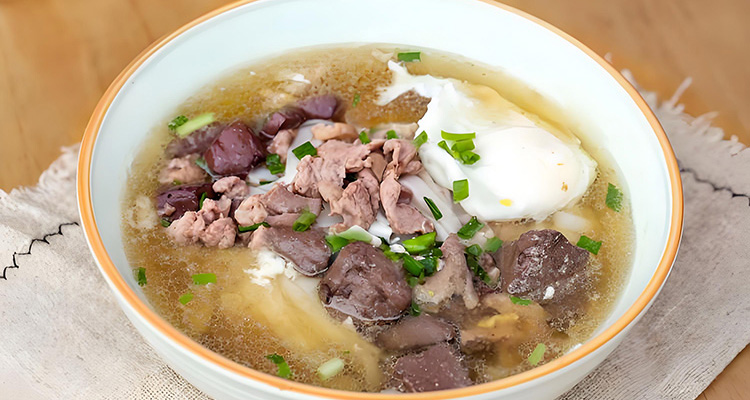Tongling Shazhu Rice Noodles: Authentic Anhui Breakfast
1. Discovering Tongling Flavor: A Bowl of Shazhu Rice Noodles
In Tongling, Anhui Province, the morning air often carries a warm, savory aroma from street stalls serving steaming bowls of Shazhu Rice Noodles. More than a breakfast item, this dish—made with fresh pork, assorted offal, springy rice noodles, and a soul‑warming pork‑bone broth—is a local ritual and a direct taste of Jianghuai everyday life. For travelers seeking authentic culinary experiences, trying a freshly made bowl of Tongling shazhu rice noodles is essential to connect with local food culture.
2. Origin and Heritage: Agrarian Wisdom in a Bowl
The origins of Tongling Shazhu Rice Noodles are rooted in the Jianghuai region’s farming traditions. Historically, slaughtering a family pig before the Lunar New Year was a community event. To avoid waste and celebrate abundance, families quickly cooked the freshest pork and offal in a large pot, serving it with rice noodles or wheat noodles to neighbors and relatives. This practical, communal dish carried the flavors of harvest, hospitality, and resourcefulness.
Over time, this homey specialty moved from villages to town markets and eventually became a distinctive Tongling street food. The dish retains an uncompromising commitment to freshness—traditionally using pork slaughtered that same morning—and has evolved from a festive meal to an everyday breakfast that locals rely on to start their day.

3. Ingredients Uncovered: Freshness as the Soul
The appeal of Shazhu Rice Noodles lies in strict attention to ingredient quality. Every flavor builds on fresh, high-quality produce.
- Main Proteins: Authentic bowls use pork butchered that morning. Lean cuts such as tenderloin or foreleg are thinly sliced so they cook instantly in boiling broth, staying tender and juicy. Common offal includes liver, kidney, and coagulated blood, each offering unique textures: silky liver, tender blood, and crisp kidney.
- Broth: The broth is the dish’s soul. Many vendors start simmering pork bones—sometimes with a few old hens or aromatics—the night before, slowly extracting marrow and collagen for a milky, deeply savory stock. This long-simmered, umami-rich broth defines the bowl’s character.
- Rice Noodles: Locally or regionally produced fresh wet rice noodles are preferred for their springy texture and rice aroma. They hold up well in hot broth and absorb its flavor without turning mushy.
4. Craftsmanship: Speed and Precision
Making Tongling Shazhu Rice Noodles looks simple but demands precise timing. The whole assembly often takes just a few minutes and is a small culinary performance.
Chefs scoop a nest of white rice noodles into a skimmer and briefly blanch them in rolling broth until tender. Thin slices of pork and offal are then briefly dipped into the hottest part of the pot—usually the center—where the intense heat cooks them in 20–30 seconds, sealing juices and freshness. Ingredients are arranged over the noodles and finished with a ladle of steaming, milky broth and a sprinkle of green onion or cilantro. This quick-blanch technique preserves the meat’s tenderness and vivid flavors.

5. Flavor and Texture: A Multi-Layered Harmony
A served bowl immediately engages sight and smell: a pale, creamy broth dotted with pinkish meat, deep red coagulated blood, and bright green scallions. The first sip delivers the rich umami of long-simmered pork bones, warming and invigorating on a cool morning.
A mouthful of rice noodles paired with a thin pork slice or tender liver reveals a balance of textures and flavors: springy noodles, savory meat, and subtle sweetness of the broth. Offal provides contrast—silky liver, tender blood, and occasionally crisp kidney—making every bite unique. Overall, the taste is savory, richly satisfying but not greasy, and deeply comforting.
6. How to Eat It: Tasting Tips Like a Local
There’s a local etiquette to fully appreciating Shazhu Rice Noodles. Many Tongling residents recommend sipping the plain broth first to savor its pure flavor before adding condiments. Common additions include chili oil, aromatic vinegar, soy sauce, pickled mustard greens, or crushed chilies.
- Add chili oil for heat and depth.
- A few drops of black vinegar can brighten the bowl and cut richness.
If you’re new to the dish, taste the broth first, then gradually adjust with condiments to find your preferred balance. Pairing the noodles with a tea egg or a fried local snack makes for a complete and satisfying breakfast.

7. Cultural Experience and Traveler Tips
Eating Shazhu Rice Noodles is as much about atmosphere as it is about flavor. To experience it fully, wake early and visit a busy local noodle shop between 7:00 and 9:00 a.m., when vendors serve the first, most flavorful stock.
- Best Places: Old commercial streets like Changjiang Road and Yian Avenue host many well-regarded noodle stalls. Follow local queues or ask hotel staff for authentic recommendations.
- Timing: Most traditional shops close after midday, so morning is essential.
- Ordering Tips: Tell the cook your preferences—extra broth, more liver, or hold the cilantro. Prices are very affordable; a generous bowl typically costs just a few U.S. dollars.
8. Simple Home Version: Recreate a Taste of Tongling
You can attempt a simplified version at home that captures the essence, if not the full depth, of the original.
Ingredients: pork tenderloin, optional pork liver, fresh or dried rice noodles, pork bones or broth base, scallions, ginger.


